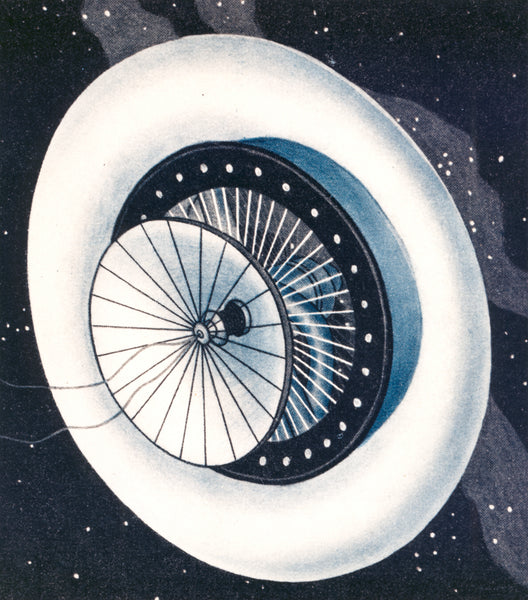But people had been dreaming about space stations long before.
Check the article below to see a few designs that didn't make it to space (yet).
Noordung's Space Station Habitat Wheel (1929)

1929 Hermann Noordung depiction of a space station habitat wheel. Hermann Potocnik (1892-1929), also known as Herman Noordung, created the first detailed technical drawings of a space station. Power was generated by collecting sunlight through the concave mirror in the center. This was one of three components of Noordung's space station. The other two were the observatory and the machine room, each connected to the habitat by an umbilical.
Noordung's Three-Unit Space Station Concept (1929)

This 1929 Hermann Noordung image depicts a three-unit space station as seen from a space ship. Hermann Potocnik (1892-1929), also known as Herman Noordung, created the first detailed technical drawings of a space station. The three units were the habitat, the machine room, and the observatory, each connected by an umbilical. The Earth is in the background, approximately 26,000 miles away. The station in this image is roughly above Cameroon's southern tip, in a geosynchronous orbit on the median of Berlin.
Atlas Tank Space Station (NASA 1958)

An empty Atlas forward propellant tank would be reclaimed as living habitat:

Three-Radial-Module Space Station Concept (NASA 1964)

This three-radial-module space station concept was intended to utilize Apollo hardware to deploy the station and to transfer crews to and from orbit.
Transfer crews to and from orbit with the Apollo spacecraft
2001: A Space Odyssey Space Station (1968)

Space station concept form the movie 2001: A Space Odyssey.
Artificial Gravity Space Station (1969)

A 1969 station concept. The station was to rotate on its central axis to produce artificial gravity. The majority of early space station concepts created artificial gravity one way or another in order to simulate a more natural or familiar environment for the health of the astronauts. After returning from a micro-gravity environment, astronauts find their muscles weak because they have not been using them. Long-term exposure to micro-gravity could generate long-term health problems for astronauts who do not utilize their muscles. This is why there are exercise machines on space shuttles and on the International Space Station. It was to be assembled on-orbit from spent Apollo program stages.
Rotates on its central axis to produce artificial gravity. To be assembled during the Apollo missions
Spider Space Station Concept (NASA 1977)

A 1977 concept drawing for a space station. Known as the "spider" concept, this station was designed to use Space Shuttle hardware. A solar array was to be unwound from the exhausted main fuel tank. The structure could then be formed and assembled in one operation. The main engine tank would then be used as a space operations control center, a Shuttle astronaut crew habitat, and a space operations focal point for missions to the Moon and Mars.
The base for mission to the Moon and Mars using Space Shuttle hardware
Roof Space Station Concept (NASA 1984)

This is the Johnson Space Center's 1984 "roof" concept for a space station. The "roof" was covered with solar array cells, that were to generate about 120 kilowatts of electricity. Within the V-shaped beams there would be five modules for living, laboratory space, and external areas for instruments and other facilities.
Power Tower Space Station Concept (1985)

This is an artist's conception of the proposed "Power Tower" space station configuration, shown with the Japanese Experiment Module attached. This model and several others were examined before deciding on the Space Station Freedom structure that was later abandoned in favor of the International Space Station.
